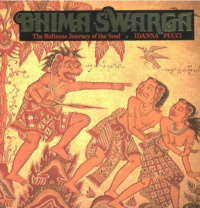Bhima Swarga: the Epic of Life - the Balinese Journey of the Soul
- Title
- Bhima Swarga: the Epic of Life - the Balinese Journey of the Soul
- Original language
- English
- Author(s)
- Illustrator(s)
- Publisher
- Alfred van der Marck
- ISBN
- 9780821218969
- Publication date
- 1985
- Subjects
- legends
- Find Book
- Out of Print but can be found in Ganesha Bookshop in Ubud.
- Related Env. Initiatives
- Related Places
- Related Biographies
- Related Children's Books
- Related Holidays
- Related Folktales
- Related Comics
- Related Lontar
- Linked words
Description(s)
his Balinese journey of the soul documents a double adventure: the hero Bhima’s epic journey to the afterlife and the author’s own exploration of his odyssey. Through a dramatic narrative filled with suspense and wonder, the reader is invited to listen as if he were part of a large Balinese audience, mesmerized by the fusion of past and present, in which the afterlife is synonymous of life itself. This episode from the ancient Mahabharata epic unfolds on 144 painted panels that line the ceiling of the royal court of justice in Klungkung, ancient seat of the Dewa Agung or “King of Kings” on the Indonesian island of Bali. The story fills the divide between different cultures, races, customs, religions, and languages in the name of universal principles. The subject is startling and timeless in its depiction of the human condition and the situation of the world. It addresses the same issues that continue to pervade all societies: greed, murder, theft, usury, political corruption, the dilemmas of abortion and homosexuality, and the crime against the environment. Miraculously surviving earthquakes, volcanic eruptions, and a huge fire during the Dutch invasion in 1908, this rare gem in the panoply of South-east Asian art and literature–known as the Kertha Gosa or place for justice–includes all aspects of Balinese culture under one roof. The paintings, depicting the suffering of Hell and the peace of Heaven, serve both as a legal codex and as a testament to man’s unending metaphysical journey.







Enable comment auto-refresher